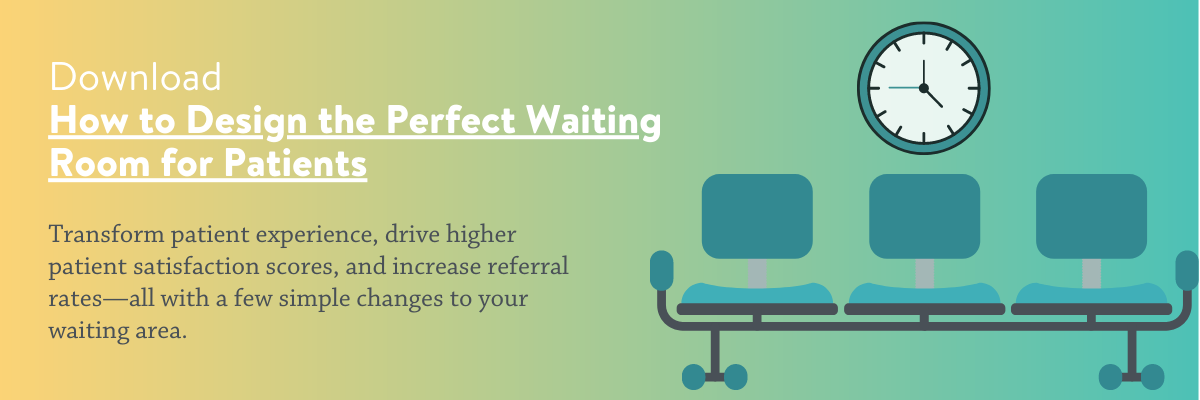Are you offering these options to patients while they wait?
The average time patients spend waiting for a doctor is just over 18 minutes, according to a 2018 report. While that is a decrease from previous years, wait time remains a significant factor in patient satisfaction. Not only did 84 percent of people say wait time is either “somewhat important” or “very important,” but 30 percent of patients reported they’ve walked out of an appointment due to long waits, and one in five said they’ve changed doctors because of long wait times.
You can’t control every factor that impacts wait time in your practice—emergencies happen—but you can influence patients’ perception of the time they spend waiting for their appointment. Consider these ways to engage patients and grow your revenue right from your waiting room.
1. Educate patients while they wait
If you’re waiting until you see patients in the exam room to discuss their health, you’re missing opportunities to educate them while they wait, encourage them to ask better questions and engage in their health care, and save yourself time.
Patients who watch educational videos in the waiting room enter the exam room up to speed on basic terminology and information.
Consider this: While they wait for their appointment, show patients informative videos about tests that may be performed, such as wide-angle retinal imaging, dry eye testing, or why a dilated eye exam is important, for instance. You can also highlight common conditions, such as chronic sinusitis, explaining how symptoms may be confused for allergies. By the time you see them in the exam room, they will be up to speed on basic terminology and may have questions fresh in their minds.
You definitely should offer free Wifi in your waiting room, and you might consider having iPads available for patient use. Talk to our Customer Success team for tips on using iPads while preventing theft or misuse. According to a 2018 UnitedHealthcare consumer survey, 36 percent of people used the internet or apps to compare health care services during the past year and 29 percent have used the internet to research health-related information. And the FDA reported that 500 million smartphone users globally are using a mobile health care application.
2. Spark interest in your products and services
Your waiting room is also an ideal place to tell patients about products and services you offer. You have a captive audience that already trusts your practice enough to make an appointment, after all. Why not inform them about new offerings or special promotions while they wait?
Showcase product offerings, special promotions, and areas of expertise in your waiting room.
For instance, many of our customers now offer cosmetic services. Do your patients know they can get Botox or eyelash-lengthening serums from the same trusted health care professional who takes care of their other needs? Show this video in your waiting room:
You should also use wait time to promote any patient-friendly policies that people may be unaware of, such as rebates and savings for contact lens wearers, as well as an “open box” return policy if their prescription changes. This is one way eye doctors can compete with online contact lens retailers and boost revenue.
And if your practice has a particular area of expertise, such as treating dry eye disease, highlight that in your waiting room as well. Dry eye affects as many as 30 million people worldwide, yet only about five percent of those have been diagnosed and treated. Many sufferers don’t even know there’s a name for their symptoms, let alone effective treatment options.
3. Encourage online engagement
Most of your patients are using social media already, so why not encourage them to engage with your practice online? Social media is an extension of the doctor-patient relationship, according to cardiologist Kevin Campbell, M.D. “When physicians are active on social media sites, it affords them with an additional opportunity to reach patients and impact the daily choices that patients make,” he told Forbes. Also, social media is a simple and fast way to reach hundreds of thousands of patients.
Invite patients to interact with and “like” your practice on social media. The majority of patients today find online reviews to be a reliable way to choose a doctor.
Facebook remains one of the most widely used social media sites among adults in the U.S., according to Pew Research Center. Roughly seven in 10 adults (69 percent) say they use the platform. If you have an active Facebook page, promote a Facebook poll for patients to take. Play Rendia’s “Like us on Facebook!” video on any screens or TVs.
More patients are using online review sites to choose doctors, and they increasingly trust those reviews. A recent survey of 1,000 U.S. adults found that 95 percent of respondents—and 97 percent of millennials—believed online ratings and reviews to be reliable. And 70 percent said that online ratings and review sites had influenced their choice of doctor.


